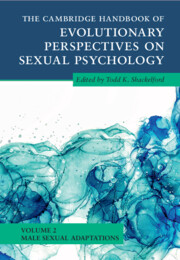Book contents
- The Cambridge Handbook of Evolutionary Perspectives on Sexual Psychology
- The Cambridge Handbook of Evolutionary Perspectives on Sexual Psychology
- Copyright page
- Contents
- Contributors
- Preface
- Part I Precopulatory Adaptations
- Part II Copulatory Adaptations
- Part III Postcopulatory Adaptations
- 14 Postejaculatory Adaptations to Self-Semen Displacement
- 15 Male Mate Retention
- 16 Shifts in Partner Attractiveness
- 17 Emotional Commitment in Men
- 18 Sexual Jealousy in Males
- 19 Men’s Attachment-Related Needs in the Sexual Arena
- 20 Paternal Care
- 21 Paternal Filicide
- Index
- References
15 - Male Mate Retention
from Part III - Postcopulatory Adaptations
Published online by Cambridge University Press: 30 June 2022
- The Cambridge Handbook of Evolutionary Perspectives on Sexual Psychology
- The Cambridge Handbook of Evolutionary Perspectives on Sexual Psychology
- Copyright page
- Contents
- Contributors
- Preface
- Part I Precopulatory Adaptations
- Part II Copulatory Adaptations
- Part III Postcopulatory Adaptations
- 14 Postejaculatory Adaptations to Self-Semen Displacement
- 15 Male Mate Retention
- 16 Shifts in Partner Attractiveness
- 17 Emotional Commitment in Men
- 18 Sexual Jealousy in Males
- 19 Men’s Attachment-Related Needs in the Sexual Arena
- 20 Paternal Care
- 21 Paternal Filicide
- Index
- References
Summary
In species with internal female fertilization, males face the problem of paternity uncertainty, which refers to the risk of investing in unrelated offspring. As such, a partner’s sexual infidelity may be particularly damaging for males given that it may result in allocating resources to genetically unrelated offspring, reducing a male’s inclusive fitness. As such, males invest considerable time and effort to retain their mates. Mate retention tactics involve cost-inflicting strategies that operate by reducing the partner’s self-perceived value to prevent the partner from leaving the partnership, and benefit-provisioning strategies that operate by boosting a partner’s self-esteem and improving relationship satisfaction. In this chapter, first, we discuss the benefits that men gain from long-term relationships, which include increased probability of paternity, prolonged proximity and sexual access to a partner, and increased probability of attracting a high-quality partner. Second, we discuss the main costs of infidelity for males, including the risk of investing in an unrelated child as well as costs to his reputation and future mating opportunities. Third, we define and discuss a taxonomy of mate retention tactics and explain that a male’s mate retention tactics are expected to respond to his female’s partner preferences, at least partly. Indeed, males have been found to engage in tactics such as resource display given that females value mates that are able and willing to provision them and their offspring with resources. Empirical evidence has also, surprisingly, found that men, more than women, engage in strategies such as submission and debasement. Empirical evidence also suggests that men also use threats and violence directed to rivals more than women do. Our review also demonstrates that males engage in both benefit-provisioning and cost-inflicting mate-retention strategies, and that the type of strategy chosen as well as its intensity is partly dependent on a man’s mate value and his ability to acquire resources. Finally, we discuss some of the main environmental factors that may influence the mate retention tactics displayed by males, including partner mate value and perceived infidelity threat.
Keywords
- Type
- Chapter
- Information
- Publisher: Cambridge University PressPrint publication year: 2022



